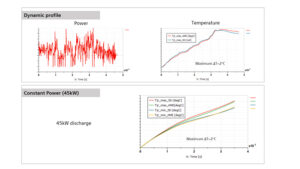French automotive manufacturer uses Simcenter Amesim to optimize battery pack and reduce costs
Siemens solutions enable PSA Peugeot Citroen to reduce product development time from months to weeks
Navigating the road to electrification
The year 2020 is key for the automotive industry. New regulations and carbon dioxide (CO2) emission standards for cars mean there is no way around electrification. All external factors are converging, including government incentives, tighter regulations and falling battery prices. Boston Consulting Group’s (BCG) latest global automotive powertrain forecast shows sales of electrified vehicles (xEVs) growing even faster than expected. According to BCG, these cars will command one-third of the market by 2025 and 51 percent by 2030, surpassing sales of vehicles powered purely by internal combustion engines (ICEs).
All original equipment manufacturers (OEMs) are speeding up plans to electrify cars, and the PSA Groupe is no exception. The group has been committed to clean and sustainable mobility for quite a while so the choices they made in the past make it ready to play its part in the energy transition. PSA Peugeot Citroen’s objective is to have its range of vehicles completely electrified by 2025.
The battery is at the heart of electrification
The battery is a key component for enabling electrified vehicles to meet customer expectations. Range anxiety remains an important barrier to address. Most electrical vehicle batteries have an eight-year warranty or a 160,000-kilometer (km) (100,000-mile) drive limit. Therefore, OEMs have to develop strategies to slow down battery aging. One of the most impactful criteria for battery aging is the temperature variation that it endures. Although there is larger battery capacity at high temperatures, it drastically shortens battery life. Thermal management of batteries is critical for achieving optimal temperatures for any driving condition. This enables the user to determine the perfect balance between capacity and battery life.
In this context, it is crucial for the battery cooling system to be designed in a way that balances other vehicle performance attributes and optimizes battery capacity versus life. On the one hand, it cannot be oversized as it would impact overall vehicle performance because it would be too heavy, require additional money to build a more complex system and degrade vehicle aerodynamics. On the other hand, it cannot be undersized because it would risk compromising the safety of the vehicle, driver and passengers. On top of this, it is critical to design cars that strike the optimal balance between conflicting attributes like comfort, driving pleasure, performance and durability.
To cope with these challenging design requirements, OEMs need to adapt to new development priorities and build an engineering organization mapped around those key areas. PSA Peugeot Citroen had to make a strategic move in that direction. Angelo Greco, who is team leader of battery system modeling and design, focuses on functional design analysis and multi-physics modeling. Battery design and integration is at the crossroads of innovation and needs to fulfil challenging demands, not only for marketing requirements, but also for passenger safety and comfort to define the right components for the vehicle.
Defining the right battery for specific objectives
– The main challenge is that we can’t make proper battery design analysis and evaluation without integrating it in the complete vehicle architecture, says Greco. It is very complex because you have to take into account its multi-physics nature, including electrical, thermal, cooling and control parts in the same model. It is not an easy task and that’s why we chose Simcenter Amesim to work on that engineering challenge.
Engineering the optimal battery thermal management system design and architecture while balancing costs, range, thermal comfort and durability is a critical task. Decisions must be made considering not only thermal safety and its impact on durability, but also on range and performance, cabin comfort and battery temperature. Multi-level modeling and multi-physics simulations have become pivotal for evaluating the impact of the architecture design on key performance attributes and anticipating control strategies validation.
– On top of those engineering constraints, we have strict development time requirements to maintain a competitive time-to-market, says Greco. We have to be very agile. Sometimes we have to change a component or a model within a week or a day and adapt to new requirements or data from the supplier. The versatility of the multi-physics models is key to be able to realistically assess the impact of changes on the expected performance levels. That is one of the reasons we decided to use Simcenter Amesim for our multi-physics analysis as it helps us remain agile.
Developing battery system model from 3D design
 To analyze battery thermal management, Greco has to understand how the battery is designed by PSA Peugeot Citroen suppliers. Tier suppliers usually size and develop the battery module by considering the worst use-case conditions to ensure the electric vehicle works under any conditions and the battery life range aligns with the eight-year warranty and meets regulation requirements.
To analyze battery thermal management, Greco has to understand how the battery is designed by PSA Peugeot Citroen suppliers. Tier suppliers usually size and develop the battery module by considering the worst use-case conditions to ensure the electric vehicle works under any conditions and the battery life range aligns with the eight-year warranty and meets regulation requirements.
Nevertheless, the battery is often oversized and so is the cooling system. Consequently, it costs more development time but also reduces the overall vehicle performance. According to Greco, “Oversizing the battery pack is a safe bet, but it leads to increased costs. And this can definitely be optimized. Having access to simulation enables PSA Peugeot Citroen to rapidly analyze battery performance and its thermal management. Further, it enables the firm to investigate alternative battery designs, validate them virtually and to make sure they meet the required levels of performance without compromising safety. We can also transmit required improvements to battery suppliers.”
The only way to reach the best optimization levels is to use multi-physics and dynamic models with the accuracy of 3D computation and the flexibility of 1D simulation.
– We used to assess battery thermal management using 3D battery modeling for both static evaluation and cell thermal flow modeling, says Greco. This happened too late in the development cycle and didn’t allow you to anticipate any change in the battery design. So, it has been fundamental to find a way to transcribe a 3D thermal and hydraulic model into a 1D model with the addition of the electrical part in order to evaluate the battery thermal management in a reliable way early in the development cycle.
 To succeed, Greco developed a methodology to develop a 1D model of the battery from a 3D thermal model using a nodes network. He reached similar results to the 3D thermal-hydraulic modeling but in shorter runtimes. “We used Simcenter Amesim to develop this approach that helped us not only save simulation runtimes, but also asses the dynamic thermal management of the battery versus a static assessment that we usually achieved using 3D thermal model for the battery coupled to a 3D CFD (cooling plate) model.”
To succeed, Greco developed a methodology to develop a 1D model of the battery from a 3D thermal model using a nodes network. He reached similar results to the 3D thermal-hydraulic modeling but in shorter runtimes. “We used Simcenter Amesim to develop this approach that helped us not only save simulation runtimes, but also asses the dynamic thermal management of the battery versus a static assessment that we usually achieved using 3D thermal model for the battery coupled to a 3D CFD (cooling plate) model.”
Challenging the supplier to obtain better cell design
Greco mainly worked on battery design for mild hybrid and electrical vehicles. – By using the models built with Simcenter Amesim, we have been able to run our studies twice as fast on average compared to our classical procedure – for the model development and validation of components of the pack with the addition of its multi-physical features. Indeed, from the battery model provided by the supplier using the 3D to 1D simulation approach, I have been able to show the battery could have an overall thermal resistance of 0.9K/W (worst case) instead of the 1.8K/W proposed by the supplier. The new design (0.9K/W) was able to reject as twice as much heat compared to the supplier proposal, for the same cooling conditions, providing the expected performance required in the technical specification.
Greco established that methodology early in the development cycle of a new electrical vehicle that enabled him to also opt for an “intrusive” design. Therefore, Greco explains, “The multi-physics simulation and results help us to predict performance but also to challenge the battery supplier to make them design a battery pack as efficient as the one they propose but requiring a more optimal thermal management system.”
Saving time thanks to improved simulation engineering methodology
– Having developed that nodes network methodology to model the battery thermal management has been a great move forward to propose very detailed and specific battery design requirements and challenge the supplier, explains Greco.
This improved methodology enables the team in charge of battery modeling to make decisions earlier in the development cycle and define a battery architecture that enables them to reach reliability and safety criteria for an optimal overall vehicle performance. – With Simcenter Amesim, in some projects we reduced product development time from months to weeks using multiphysics modeling. The assembly is straightforward – sometimes an afternoon is enough – as the Simcenter Amesim framework and philosophy is compatible with our multi-physical approach and therefore is it very easy to do so.







